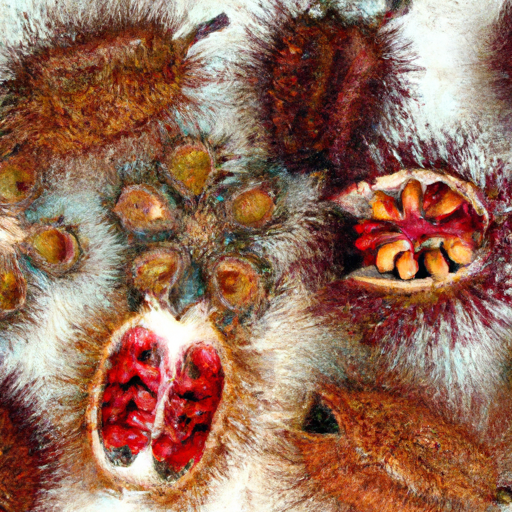The Vibrant Spice: Achiote
Are you looking to enhance the flavors and colors of your dishes? Look no further than achiote, the vibrant spice that brightens up any recipe it touches. With its rich history, unique taste, and versatile nature, achiote is a must-have ingredient in any kitchen. Let’s dive into the world of achiote and discover why it deserves a place in your culinary repertoire.
Origin and History
Achiote, also known as annatto, is derived from the seeds of the achiote tree (Bixa orellana), which is native to the tropical regions of Central and South America. This ancient spice has been used for thousands of years, dating back to the Mayan and Aztec civilizations. It was highly prized not only for its vibrant red hue but also for its medicinal and culinary properties.
Taste and Aroma
The aroma of achiote is earthy and slightly peppery, resembling a combination of nutmeg, cinnamon, and cloves. Its flavor is complex, offering a mild bitterness along with a subtle hint of sweetness. It brings a unique depth to dishes while imparting a warm and rich taste that is often described as smoky.
Culinary Uses
Achiote is an incredibly versatile spice that can be used in various forms and preparations. The most common way it is utilized is by infusing its vibrant colors and flavors into oils or as a paste. One popular method is to soak the seeds in hot water or vinegar, grinding them into a paste, and then incorporating it into recipes.
In Latin American and Caribbean cuisines, achiote is an essential component of various dishes. From the renowned Mexican Yucatan-style dish cochinita pibil (slow-roasted pork) to the Puerto Rican sofrito (a flavor-packed sauce), achiote adds a distinctive taste and a stunning reddish-orange hue to these culinary creations.
Furthermore, achiote can be used as a natural food coloring agent, bringing a beautiful golden or deep orange tint to foods like rice, cheese, and butter. It is also a key ingredient in the seasoning blends of many dishes, such as Jamaican jerk seasoning and Filipino adobo.
Nutritional Value
Apart from its culinary benefits, achiote offers several nutritional advantages. It is a good source of carotenoids, which are antioxidants that can support eye health and boost our immune system. These compounds also exhibit anti-inflammatory properties, promoting overall well-being. Achiote is also rich in iron, providing a valuable mineral that helps transport oxygen throughout our bodies.
Fascinating Facts
In the ancient Mayan civilization, achiote was not only used for cooking but also in body painting and as a natural sunscreen due to its deep red color.
Achiote was referred to as the “lipstick tree” by Spanish explorers who encountered Indigenous communities using it to decorate their lips and faces.
In certain regions, achiote is believed to have aphrodisiac properties and is used as a traditional remedy for various ailments.
Incorporating Achiote Into Your Culinary Adventures
Ready to introduce achiote into your cooking repertoire? Here are a few inspiring ideas to get you started:
Create a flavorful marinade by combining achiote paste with citrus juices, garlic, and spices, perfect for grilling or roasting meats.
Infuse your oils with achiote seeds, allowing their vibrant color and taste to permeate your dishes.
Add a pinch of ground achiote to your rice dishes, stews, or sauces for an additional layer of flavor.
Elevate your quesadillas, tacos, or empanadas by incorporating achiote into the fillings, offering a delightful burst of color and taste.
Remember, a little goes a long way with achiote, so start with small amounts and adjust to your desired taste. Let your culinary creativity blossom by exploring the magic of this vibrant spice!
Now that you’re equipped with the knowledge of achiote’s history, taste, culinary uses, and nutritional benefits, it’s time to embrace its vibrant allure. Bring the flavors of Latin America and the captivating shades of achiote to your next culinary adventure. Happy cooking!
Note: Always exercise caution and consult your doctor if you have any allergies or specific health concerns related to incorporating achiote into your diet.
Achiote
Origin: Achiote, also known as annatto, is derived from the seeds of the Achiote tree (Bixa orellana), which is native to the tropical regions of the Americas, particularly the Caribbean and Central America. It has a long history of use in Latin American and Caribbean cuisines.
Common Uses: Achiote is primarily used as a natural colorant and flavoring agent in various culinary applications. It is commonly used to give a vibrant red or orange color to dishes, such as rice, stews, sauces, and marinades. Achiote paste is also created by combining ground achiote seeds with spices, which is often used as a seasoning in traditional dishes like cochinita pibil and achiote chicken.
Nutritional Benefits: Achiote is a good source of nutrients and antioxidants. While its nutritional profile can vary, achiote is generally rich in carotenoids, including bixin and norbixin, which are responsible for its vibrant color. These compounds have antioxidant properties and may offer health benefits, such as protecting against free radicals and inflammation.
Unique Properties: Apart from its culinary uses, achiote has been utilized for various purposes throughout history. It has traditionally been used as a natural dye for textiles and body paint due to its intense reddish color. Achiote seeds were also used in traditional medicine, believed to have properties that promote healthy digestion and skin.
Historical Significance: Achiote has a long history of use by indigenous cultures. It was highly valued by the ancient Mayans and Aztecs, both for its culinary and medicinal properties. Achiote seeds were even used as a form of currency during the Mayan civilization. In present times, achiote continues to remain an important ingredient in Latin American and Caribbean cuisines, representing cultural traditions and flavors.




Use the share button below if you liked it.
It makes me smile, when I see it.